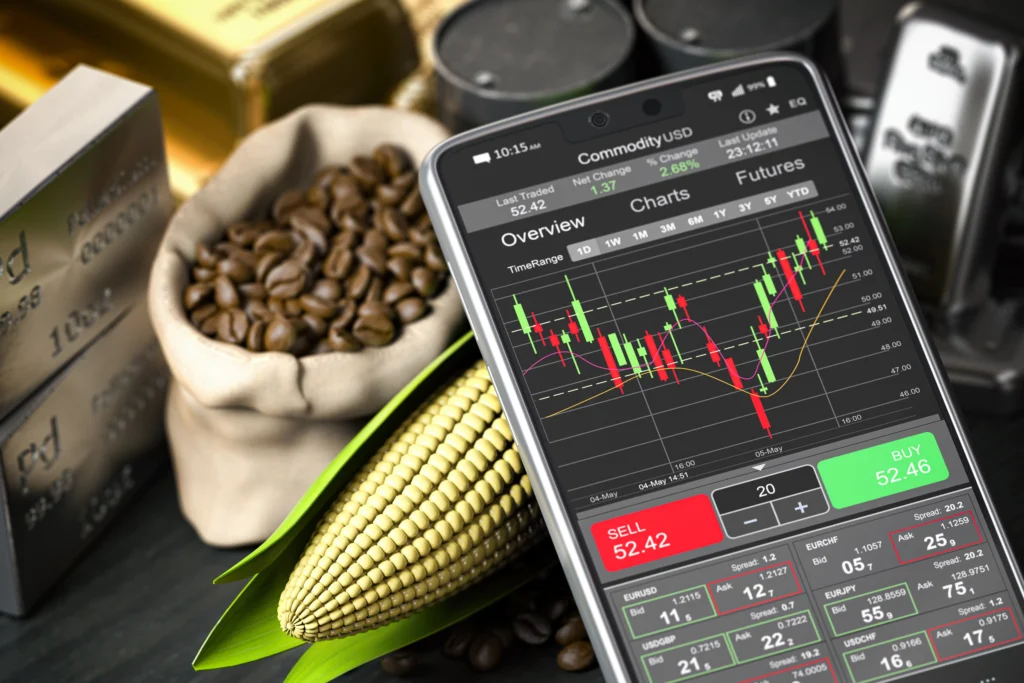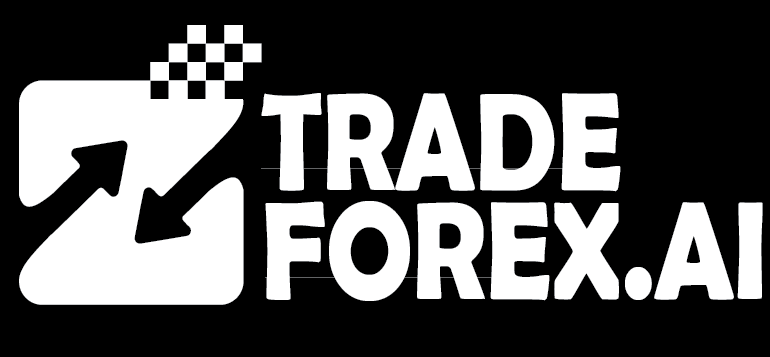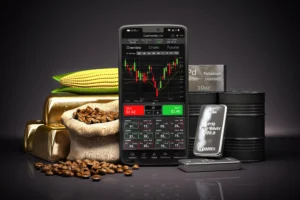What Are Commodities?
To master how to trade commodities, start by understanding their role in global economies. Commodities are natural resources or raw materials produced in large quantities for global use. They include energy resources such as crude oil and natural gas, metals like gold, copper, and aluminum, and agricultural goods such as wheat, soybeans, and cotton.
Commodities are vital because they form the foundation of production and consumption worldwide. Manufacturers, investors, and governments rely on them to stabilize industries and protect against inflation.
They’re divided into two categories:
- Hard commodities: These are mined or extracted, such as oil, coal, and precious metals. They respond strongly to global industrial demand, mining output, and geopolitical conflicts.
- Soft commodities: These are grown or produced through farming, like corn, sugar, and livestock. They’re affected by climate patterns, agricultural policies, and consumer demand cycles.
Trading commodities enables diversification. Unlike equities, their prices often move opposite to stock indices during inflation or crises. For instance, gold typically rises during economic uncertainty, acting as a “safe haven.”
By understanding Commodity Markets Explained, traders gain a clear view of how global demand, supply, and logistics interact. Those who analysis macroeconomic conditions and price relationships can manage commodity trading risks and rewards more effectively while pursuing steady returns.

How Commodity Trading Works
Learning how to trade commodities means understanding the framework of global trading systems. Commodity trading takes place through organized exchanges where buyers and sellers agree on standard contracts to ensure transparency and trust.
Trading is mainly divided into two methods: physical trading and derivative trading. Physical trading involves direct ownership and delivery, while derivatives—like futures and options in commodity trading—focus on price movements rather than physical goods.
Here’s how it works in practice:
- Spot trading: Transactions occur immediately at current market prices. For example, an airline may buy jet fuel on the spot market to secure supply for operations.
- Futures contracts: These are agreements to buy or sell a specific quantity at a set price in the future. If oil trades at $80 and you expect it to rise, buying a futures contract allows profit if prices increase before expiry.
- Options contracts: Options provide flexibility to manage uncertainty. A call option benefits from rising prices, while a put option benefits from falling prices. Traders use these to hedge open futures positions.
- Clearinghouses and margins: Exchanges like CME, ICE, and MCX ensure trade security. Traders must maintain margins—collateral that prevents default risk.
Modern commodity markets rely heavily on technology. AI-based trading systems, algorithmic models, and automated order execution now help manage positions faster and more accurately. These tools improve precision and mitigate commodity trading risks and rewards.
By understanding how contracts work and how margins amplify exposure, traders can safely leverage opportunities while managing risk exposure in volatile markets.
Types of Commodities Markets
Understanding Commodity Markets Explained is essential for choosing the right trading environment. The global market is structured into several interconnected platforms:
- Spot Markets:
In spot markets, commodities are traded for immediate delivery. Prices here reflect real-time demand and supply. A bakery purchasing wheat at current rates or an energy firm buying crude oil for immediate refining are examples. - Futures Markets:
Futures markets form the core of speculative and hedging activity. Contracts allow producers, consumers, and traders to fix future prices, reducing uncertainty. A farmer can sell futures to lock in a selling price before harvest, ensuring stability despite potential price drops. - Options Markets:
Options offer flexibility for strategic positioning. If gold trades at $2,000 and you expect a rise, a call option allows profit with limited risk. If the market declines, only the option premium is lost. Futures and options in commodity trading combine speculation and insurance effectively. - Over-the-Counter (OTC) Markets:
OTC contracts occur privately between parties. While customisable, they carry higher counterparty risk since there’s no exchange guarantee.
Together, these markets provide liquidity, facilitate price discovery, and create opportunities for traders worldwide. Understanding them helps identify which instruments align best with your capital, goals, and commodity trading risks and rewards.
Commodity Trading Strategies
Developing effective commodity trading strategies defines success. Markets fluctuate based on macroeconomic trends, supply shifts, and investor psychology. Using the right approach ensures consistent performance and reduced risk exposure.
Trend-Following Strategy
Trend following captures long-term movements. Traders rely on tools like moving averages, the relative strength index (RSI), and MACD to identify upward or downward momentum.
- How it works: Traders buy when prices consistently rise above their average or sell when prices fall below it.
- Example: During 2022’s oil rally, trend followers earned strong returns by holding long positions as prices surged past $100.
- Risk control: Set trailing stop-losses to protect profits during reversals.
This strategy aligns well with investors who prefer predictable, data-driven decisions and want to limit emotional interference while learning how to trade commodities logically.
Range Trading Strategy
Range trading suits periods when commodity prices move sideways within defined highs and lows. Traders profit from predictable reversals instead of strong trends.
Identify the range:Look for clear price ceilings (resistance) and floors (support) where buying and selling pressure balance out.
Execute the trade:Buy near support and sell close to resistance. Focus on small, consistent profits from repeated price swings.
Control risk: Place tight stop-loss orders beyond range limits to exit quickly if a breakout occurs.
Example: If silver stays between $22 and $26 for weeks, traders can enter near $22 and exit near $26 several times for steady gains.
Range trading performs best in quiet markets with moderate volatility. When combined with insights from Commodity Markets Explained, it helps traders detect early signals of potential breakouts.
Fundamental Analysis in Commodities
Fundamental analysis helps traders see beyond charts and price action. It examines the forces shaping supply and demand, allowing better decision-making in commodity trading strategies.
Key fundamentals include:
- Economic growth trends: Industrial demand for metals and energy increases when economies expand. A slowdown reduces consumption and weakens prices.
- Geopolitical tensions: Wars, trade sanctions, and diplomatic disputes disrupt supply chains. For example, sanctions on Russia caused massive volatility in oil and gas.
- Currency correlations: Most commodities are priced in U.S. dollars. When the dollar strengthens, commodities generally fall, and vice versa.
- Weather and climate: Weather affects crops, energy demand, and shipping logistics. Droughts can raise agricultural prices by limiting supply.
- Inventory reports: Weekly data from agencies like EIA or USDA reveal supply pressure or shortages.
For instance, when OPEC cuts oil production, futures prices react instantly. Traders monitoring such decisions can hedge early using futures and options in commodity trading to lock in favorable rates.
A strong grasp of fundamentals turns speculation into strategy, helping manage commodity trading risks and rewardsthrough informed analysis.
Seasonal and Cyclical Trends
Every commodity follows predictable seasonal or economic cycles. Recognizing these cycles strengthens your understanding of how to trade commodities effectively.
- Agricultural cycles: Crops like corn, soybeans, and coffee fluctuate with planting, growing, and harvest seasons. Prices rise before harvest and fall when supply increases.
- Energy cycles: Natural gas and heating oil prices climb during winter as heating demand peaks, then decline in warmer months.
- Industrial cycles: Copper, aluminum, and steel prices rise during construction booms and industrial growth periods.
- Commodity interdependence: Some commodities influence others—rising oil costs increase fertilizer prices, affecting agriculture indirectly.
Traders use statistical models to compare multi-year data and forecast recurring movements. However, external shocks—like floods or export bans—can distort seasonal trends, making flexibility essential.
Blending seasonal insights with Commodity Trading Strategies and Commodity Markets Explained provides structure while accommodating unexpected price shifts.
Managing Risks in Commodity Trading
Managing risk is central to learning how to trade commodities responsibly. Since commodities are sensitive to macroeconomic and political factors, disciplined risk control prevents major financial losses.
Price Volatility Risks
Volatility reflects the speed and extent of price changes. High volatility creates both opportunity and danger. Traders should:
- Monitor volatility indices to adjust leverage during turbulent periods.
- Use stop-loss orders to exit trades automatically when losses exceed limits.
- Diversify across multiple commodities to offset price fluctuations.
- Study historical data to identify average daily movement ranges.
Example: When natural gas prices surged by 60% in early 2022, traders with predefined stop levels managed losses efficiently, while others faced liquidation.
Leverage and Margin Risks
Leverage magnifies gains but can destroy accounts if unmanaged. To control risk:
- Use leverage only when volatility is low.
- Maintain adequate margin reserves to avoid forced liquidation.
- Avoid overexposure to a single contract or commodity type.
- Understand that leverage enhances both profit and loss potential.
Supply Chain & Geopolitical Risks
Commodity prices depend heavily on supply logistics. Disruptions such as wars, port closures, or sanctions cause immediate reactions. Traders mitigate these commodity trading risks and rewards by diversifying holdings across geographies.
For instance, during the Suez Canal blockage in 2021, shipping delays raised crude prices. Those with diversified exposure to regional contracts balanced the effect successfully.
Risk Management Techniques
Risk management transforms trading from speculation into a structured business. Every professional who knows how to trade commodities follows consistent techniques to safeguard capital:
- Position Sizing:
Limit exposure per trade to 1–2% of portfolio value. For example, in a $10,000 account, risk only $200 per position. This approach keeps capital safe during adverse market swings. - Stop-Loss Orders:
Predefine exit levels before entering trades. Traders using automation can execute stop-losses instantly, avoiding emotional decisions during volatility. - Diversification:
Mix exposure across sectors. Metals, energy, and agriculture respond differently to global events. Balanced portfolios reduce overall variance in returns. - Hedging:
Use futures and options in commodity trading to protect profits or limit losses. For instance, a jewelry company can hedge gold exposure through futures, maintaining stable pricing despite market swings. - Regular Monitoring:
Evaluate trades weekly or monthly. Adjust stop levels, update position sizes, and review global news affecting core markets.
Adopting these practices ensures survival during unpredictable price cycles while maintaining steady portfolio growth.
How to Trade Commodities
Executing trades successfully requires a blend of planning, education, and the right trading infrastructure. Learning how to trade commodities effectively means going beyond price charts—it involves understanding market structure, timing, and emotional control. Traders who combine discipline with research build consistency and long-term profitability.
Before placing your first trade, define your goals. Are you aiming for short-term speculation, medium-term swing trading, or long-term hedging? Each approach requires a different risk appetite, time commitment, and knowledge depth. The following steps provide a structured path to success.
Choose a Commodity to Trade
Selecting the right commodity is your foundation. Every market behaves differently, influenced by unique global and seasonal factors.
- Energy commodities: Crude oil, natural gas, and gasoline attract active traders due to high liquidity and strong reactions to geopolitical events. For example, OPEC production decisions or U.S. inventory data often trigger sharp price movements.
- Metals: Gold and silver appeal to both traders and investors as safe-haven assets during inflation or crises. Copper reflects industrial demand, making it sensitive to global growth trends.
- Agriculture: Wheat, soybeans, sugar, and coffee follow predictable seasonal cycles based on planting and harvest schedules. These are ideal for patient traders who study weather reports and crop forecasts.
When learning how to trade commodities, beginners should start with high-volume markets that offer reliable data and tighter spreads. Avoid illiquid or exotic contracts until you gain experience managing volatility and leverage.
Select a Trading Method
Choosing the correct method depends on your goals and capital. Traders have several instruments to access the market:
- Futures contracts: The most direct and popular tool, offering high liquidity and leverage. Futures suit active traders comfortable with short-term price movements.
- Options contracts: Options provide flexibility and limited risk exposure. Buying a call option lets you benefit from price increases while capping your maximum loss at the premium paid.
- Exchange-Traded Funds (ETFs): Commodity ETFs mirror the price of gold, oil, or broad indices, making them ideal for passive investors who prefer lower risk and no margin requirements.
- Contracts for Difference (CFDs): CFDs allow speculation on price movements without owning the underlying asset. They are accessible but demand strong risk management since they are leveraged instruments.
Balancing futures and options in commodity trading with ETFs creates a diversified approach that suits both short-term traders and long-term investors.
Find a Reliable Broker or Exchange
Your broker determines your access, costs, and execution quality. Always choose a regulated broker authorized by global bodies like SEBI in India, CFTC in the U.S., or FCA in the U.K. Regulatory oversight ensures transparency and client fund protection.
Before opening an account, evaluate the broker’s:
- Platform reliability: The system should offer fast execution during volatile conditions without lag.
- Research tools: Look for integrated charting, technical indicators, and access to live market data.
- Support and education: Quality brokers provide tutorials, webinars, and market analysis that help traders learn continuously.
- Fee transparency: Confirm spreads, commissions, and margin requirements. Hidden costs can erode profitability over time.
In India, exchanges like MCX and NCDEX are highly active and support a wide variety of futures and options contracts. Globally, CME and ICE remain industry standards for professional traders.
Develop a Trading Plan
A solid plan is the backbone of success when mastering how to trade commodities. It removes emotional decisions and keeps trading systematic. A professional trading plan includes:
- Entry and exit rules: Define exactly when to enter and exit trades using clear criteria such as breakouts, moving averages, or macroeconomic triggers.
- Risk-per-trade limit: Restrict exposure to 1–2% of total capital on each position to protect long-term sustainability.
- Daily loss limits: Stop trading after hitting a predefined daily or weekly drawdown to avoid emotional decisions.
- Pre-trade checklist: Confirm position size, margin requirements, stop-loss orders, and upcoming economic reports before entering trades.
- Trading journal: Document every trade with entry rationale, exit reason, and emotional state. Reviewing this data helps identify mistakes and improve consistency.
Discipline turns average traders into professionals. A structured plan backed by continuous review boosts confidence and enhances decision-making accuracy under pressure.
How to Trade Commodity Futures
Futures markets form the foundation of commodity markets explained worldwide. These standardized contracts let buyers and sellers agree on a specific price and delivery date for a commodity. They are widely used for both speculation and hedging, making them essential tools for producers, exporters, and investors who want predictable outcomes in volatile markets.
Trading futures successfully requires discipline, preparation, and a profound understanding of contract details.
Recognize the specifications: The size, tick value, and expiration date are specified in every futures contract. For example, one crude oil contract on the CME equals 1,000 barrels. A $1 change in price means a $1,000 shift in value. Knowing these facts helps estimate risk and reward before entering a trade.
Plan rollovers: Futures expire, so traders who wish to stay invested must close existing contracts and open new ones for the following month. Rolling over positions avoids unwanted physical delivery and keeps exposure continuous.
Manage margin: Margin is collateral used to open trades. Always maintain funds above the minimum requirement to avoid forced liquidation. Adjust exposure based on market volatility and margin calls.
Track fundamentals: Futures prices react to global events. Follow EIA inventory data, OPEC announcements, and USDA crop forecasts to anticipate market reactions. Informed traders adapt faster than those relying only on technical charts.
Control exposure: Limit leveraged positions before major news events. Sudden economic or geopolitical announcements can trigger rapid price swings.
Example: If copper futures trade at $4 per pound and rise to $4.30, a trader gains $7,500 per contract. The same fall results in an equal loss. Managing commodity trading risks and rewards through proper stop-losses and leverage control keeps long-term performance stable.
Futures trading rewards preparation and discipline, not guesswork. It’s about probability, timing, and emotional control—not chasing trends blindly.
Commodity Trading Tips
Even after mastering the basics of how to trade commodities, consistent results depend on refinement and emotional discipline. The best traders evolve with changing markets and never stop learning.
Here are practical and detailed insights for success:
Start small: Consider starting with one or two commodities. Focus on gold or crude oil—liquid markets with abundant data—before exploring volatile ones like copper or soybeans. This builds confidence and sharpens decision-making.
Follow global reports: Track OPEC meetings, EIA energy inventories, and USDA crop forecasts. These updates shape short-term direction and reveal long-term demand cycles across major markets.
Use demo platforms: Practice in simulated conditions to test strategies, entries, and exits. Build consistency in paper trading before moving to real capital.
Stay emotionally neutral: Avoid revenge trading or chasing losses. Follow your trading plan strictly and base actions on data, not impulse.
Keep learning: Study macroeconomics, policy shifts, and emerging technologies like AI in forecasting. Continuous learning expands your edge and improves adaptability.
Review weekly: Analyze trading logs for win rates, profit factors, and rule adherence. Identify recurring mistakes early and refine strategy execution accordingly.
Adopt technology: Modern platforms now use AI-driven insights and automated alerts for volatility, margin levels, and price triggers. They help minimize reaction time and execution errors.
Network and learn from professionals: Participate in trading communities, attend webinars, and engage with analysts. Shared insights about market behavior and trading psychology accelerate growth faster than studying alone.
Success in how to trade commodities depends less on luck and more on consistency, structure, and mental clarity. By combining preparation, technology, and controlled risk, traders can thrive in the competitive world of commodity markets.
Conclusion
Commodities remain essential to global trade, influencing inflation, production, and investment flows. Understanding how to trade commodities effectively transforms uncertainty into opportunity.
The path to success lies in education, patience, and structured commodity trading strategies that adapt to changing market dynamics. Balancing commodity trading risks and rewards ensures stability even during volatile conditions.
By applying data-driven analysis, controlling leverage, and leveraging futures and options in commodity trading, investors can participate confidently in one of the world’s most dynamic financial arenas.
With persistence, discipline, and continuous learning, anyone can trade commodities effectively and reduce trading risks while achieving consistent, long-term results.
Read here to learn more about “What Is the Death Cross in Trading and Why It Matters in 2025“.

I’m Chaitali Sethi — a seasoned financial writer and strategist specializing in Forex trading, market behavior, and trader psychology. With a deep understanding of global markets and economic trends, I simplify complex financial concepts into clear, actionable insights that empower traders at every level. Whether it’s dissecting winning strategies, breaking down market sentiment, or helping traders build the right mindset, my content bridges the gap between information and implementation.




